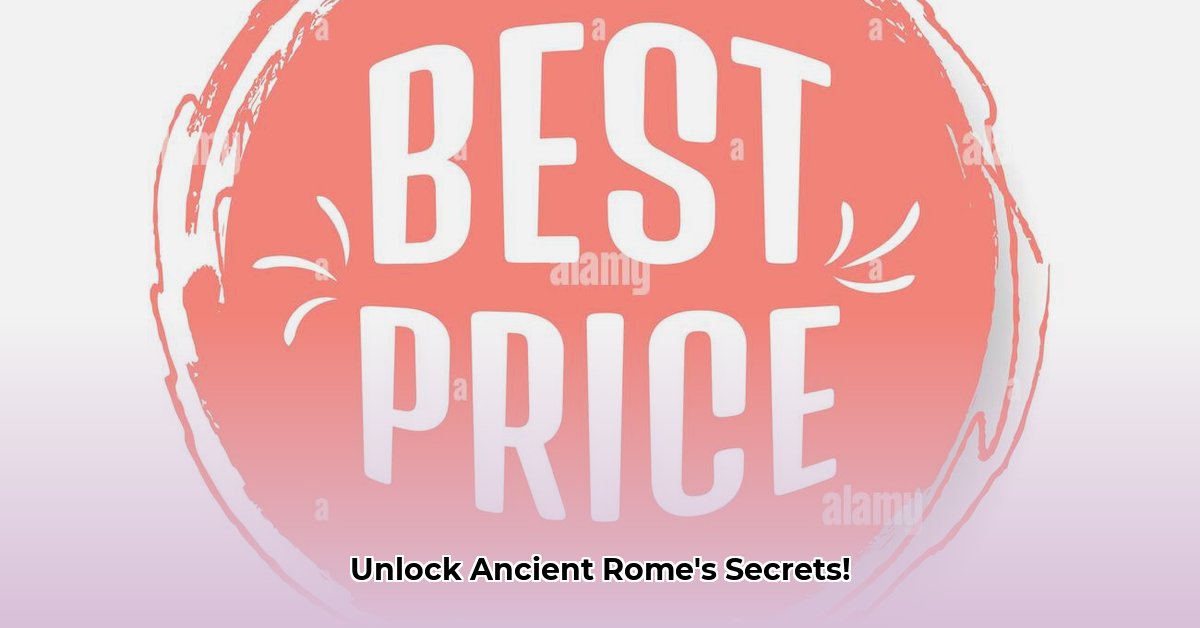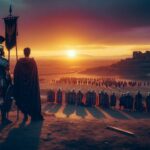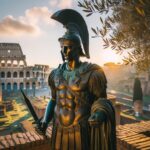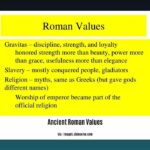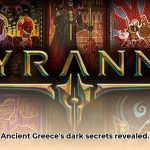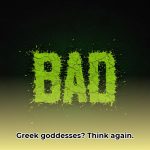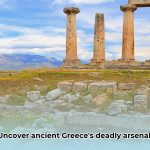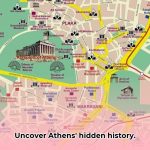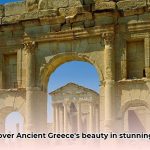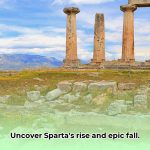Want to immerse yourself in the captivating world of ancient Rome? This curated list serves as your gateway, offering expertly recommended books tailored for every level of expertise. Whether you’re a curious beginner eager to learn about Roman warfare or a seasoned history enthusiast seeking in-depth analyses of daily life in the Empire, these options will guide you through diverse perspectives of this fascinating civilization. We’ll break down the best books by chronological period, specific topics such as political history and military history, and reader level—beginner to advanced—ensuring you discover the perfect read to satisfy your curiosity and understanding of Roman customs and society. For even more suggestions, check out this great resource.
Unveiling the Best Books on Ancient Roman History
Fascinated by ancient Rome? With countless books available, selecting the right ones can feel overwhelming. Fear not! This guide simplifies the process by categorizing the best books on ancient Roman history by chronological period, topic, and reading level. Whether you’re a newcomer or a seasoned scholar, you’ll find the perfect fit. Delve into the intricacies of Roman social history, explore compelling biographies, and uncover historical insights into the vast empire and its lasting legacy. This guide is updated for 2025 and includes recently published works, ensuring you receive the most current insights.
A Journey Through Time: Chronological Picks for Understanding Roman Civilization
Embark on a chronological exploration of Rome’s rich history with these recommended starting points. These selections provide a comprehensive view of the Roman state from its earliest days to its transformation into a sprawling empire.
- The Roman Republic (Beginner to Intermediate): Experience the tumultuous era of the Roman Republic, filled with political intrigue, ambitious generals, and the ascent of powerful families. Tom Holland’s Rubicon: The Triumph and Tragedy of the Roman Republic offers a gripping narrative focused on the Republic’s dramatic demise. While engaging, some historians might suggest it overemphasizes certain figures like Julius Caesar, potentially overshadowing the collective dynamics of the Senate. It’s a compelling story and a great introduction to the era of republican government. Consider also Cicero: The Life and Times of Rome’s Greatest Politician by Anthony Everitt to gain a deeper understanding of the political landscape and key figures of the late Republic.
- The Roman Empire (Intermediate to Advanced): Discover the grandeur and complexity of the Roman Empire. Edward Gibbon’s The History of the Decline and Fall of the Roman Empire remains a highly influential classic, offering a panoramic, if lengthy, perspective. For a more accessible approach, consider Mary Beard’s acclaimed SPQR: A History of Ancient Rome, which masterfully blends political events with the daily lives of ordinary Romans. Beard’s work is known for its scholarly rigor and accessibility, similar to Adrian Goldsworthy’s compelling narrative style. Readers interested in the emperors themselves should check out Augustus: First Emperor of Rome, also by Goldsworthy, for a detailed biography of Rome’s first emperor. For many, SPQR is a perfect starting point if you want scholarship that’s also relatively easy to read.
Diving Deeper: Exploring Specific Facets of Roman Life
Sometimes, a focused exploration of a particular aspect is desired. This curated section presents excellent books that delve into specific topics, offering detailed insights beyond the broader historical narrative.
| Topic | Recommended Reads | What You’ll Love | Things to Keep in Mind |
|---|---|---|---|
| Military History | The Complete Roman Army by Adrian Goldsworthy; Cannae: Hannibal’s Greatest Victory by Adrian Goldsworthy | Detailed analysis of Roman military strategy and campaigns; Goldsworthy combines detailed analysis with a compelling narrative voice; Cannae offers a deep dive into one of Rome’s most significant defeats and the tactical brilliance of Hannibal. | Goldsworthy’s focus is primarily on the Roman perspective; consider supplementing with accounts focusing on Rome’s adversaries for a balanced view. |
| Social History | Daily Life in Ancient Rome by Jerome Carcopino; Domina: The Women Who Made Imperial Rome by Guy de la Bédoyère | Discover daily Roman life: food, housing, social classes, and family structures; Domina sheds light on the often-overlooked roles of women in shaping Imperial Rome. | Scope varies widely; tailor your choice to specific interests; Daily Life provides a broad overview, while Domina focuses specifically on women and their influence. |
| Political History | The Twelve Caesars by Suetonius; Rubicon: The Last Years of the Roman Republic by Tom Holland | Lively biographies of Roman emperors, full of anecdotes; Rubicon vividly portrays the political turmoil and key figures of the late Republic. | Suetonius’ writings require critical reading to account for potential biases; Holland’s narrative style, while engaging, may sometimes prioritize drama over nuanced analysis. |
| Religious History | Religious Practices in Ancient Rome by various authors | Gain a valuable, intimate understanding of daily Roman existence | Requires selective searching to match specific interests. |
| Daily Roman Life | Select books focused on food, housing, entertainment, etc., such as Considerations on Roman Daily Life by Fagan. | Gain an intimate understanding of the average Roman’s existence. | Requires selective searching to match specific interests; primary source material can be invaluable but requires careful interpretation. |
Finding Your Level: Books Tailored for Every Reader
Whether you’re embarking on your Roman journey or possess extensive knowledge, selecting the right book hinges on your current expertise and interests. What era of Roman history sparks the most interest? What level of detail are you looking for?
- Beginner: Begin with SPQR due to its accessible writing style and comprehensive, yet approachable, content. Biographies of prominent Roman figures, such as Adrian Goldsworthy’s Augustus, are also excellent choices for newcomers.
- Intermediate: Enhance your knowledge with books like Rubicon or those focused on specific themes such as military campaigns (e.g., Goldsworthy’s works) or social customs (e.g., Carcopino’s Daily Life).
- Advanced: Challenge yourself with Gibbon’s monumental Decline and Fall or specialized scholarly works exploring niche subjects. For military history, consider The Ghosts of Cannae: Hannibal and the Darkest Hour of the Roman Republic by Robert L. O’Connell for a deeper understanding of a pivotal battle.
Your Next Steps: Expanding Your Roman Horizons
This list merely scratches the surface of the vast collection of Roman history books available. Each book offers a unique perspective and valuable insights into ancient Roman society. The broadness of Roman civilization ensures endless opportunities for further learning and exploration in areas like ancient warfare and political power. Did this list spark an interest in a particular Roman period or aspect? Excellent! Continue your exploration and uncover even more about this fascinating civilization. Consider exploring online resources like the Journal of Roman Studies for scholarly articles and new discoveries.
Analyzing Nuanced Perspectives on the Decline of the Roman Empire
To truly grasp the decline of the Roman Empire, you need to analyze diverse viewpoints. Historians endlessly debate this complex topic.
Dissecting the Decline: A Multifaceted Puzzle of the Empire
The Roman Empire’s collapse unfolded gradually over centuries, stemming from many factors. Internal issues like economic instability, political corruption, and widespread inequality converged with external pressures, including barbarian migrations and extensive military commitments, to undermine the empire’s foundation. The sheer size of the empire also made it difficult to govern effectively, contributing to its eventual fragmentation.
Exploring Competing Narratives: Internal vs. External Factors of Power
Historians often debate whether internal decay or external pressures contributed more significantly to Rome’s decline. Some prioritize long-term economic and social deterioration, while others emphasize military defeats and barbarian invasions. Kyle Harper’s The Fate of Rome: Climate, Disease, and the End of an Empire offers a compelling argument for the role of environmental factors. Examining these different perspectives is crucial for a comprehensive understanding.
Developing Critical Thinking Skills: Mastering Source Analysis in Roman History
Analyzing nuanced perspectives on the decline of the Roman Empire demands careful evaluation of sources. Consider the author’s background, potential biases, and the historical context of the work. What arguments are emphasized? What evidence is provided, and how does it compare with other sources? Skilled historians consider all evidence before coming to conclusions. For example, Gibbon’s Decline and Fall, while influential, reflects the Enlightenment perspective and its criticisms of religion.
Key Takeaways for Understanding Roman Decline:
- The Roman Empire’s decline was a complex and prolonged process spanning several centuries.
- Internal vulnerabilities (economic disparities, political turmoil, corruption) and external threats (barbarian incursions, military overextension) played vital roles.
- Environmental factors, such as climate change and disease outbreaks, also contributed to the decline, as highlighted by Harper’s work.
- Historians hold differing views on the relative importance of these factors.
- Comprehensive understanding requires analyzing diverse perspectives and critically evaluating sources.
- Both archaeological findings and written records provide valuable, though sometimes conflicting, information.
Navigating the Historical Landscape: A Roadmap for Deeper Study of Roman History
To truly understand the Roman decline, exploring differing interpretations is key. Books offer myriad viewpoints from leading historians. By examining these diverse perspectives, you’ll develop your own informed understanding of the rise and fall. Consider reading reviews of historical works in journals like the American Historical Review to gain further insights into scholarly debates.
Roman Military Logistics: A Comparative Study of Supply Chains and Strategies
The Roman military’s logistical prowess was fundamental to its dominance. A complex system, it ensured the army’s sustenance and operational effectiveness.
The Engine of Conquest: Roman Supply Chains
Imagine an army of thousands traversing varied terrains for months. How did they survive? The answer is the Roman military’s incredibly efficient logistical system. Books like Roman Military Logistics: A Comparative Study of Supply Chains and Strategies reveal the intricate networks sustaining Roman legions. This involved strategic planning, adaptable transport, and robust security. The Romans meticulously planned rations. Estimates hover around 3000 calories per soldier per day, but the proportion of meat versus grains remains a point of contention and requires more archaeological digging to confirm.
Efficient Transport: Land, Sea, and River
Moving supplies across vast distances presented significant obstacles. The Romans cleverly utilized transport modes. Land routes, using pack animals and carts, were crucial for shorter campaigns, while sea transport allowed for bulk movement, especially grain from provinces like Egypt and North Africa. Rivers provided efficient waterways for inland transport, with specialized boats designed for navigating shallow waters. This multimodal approach allowed flexibility and resilience in the face of logistical challenges.
Securing the Supply Lines: Defense and Fortification with Roman Military Tactics
The Romans established a tiered security system to protect their supply lines. Fortified depots, castella, provided secure storage and staging points along major roads. Strong military escorts protected convoys transporting supplies, reducing the risk of theft or sabotage by enemy forces or bandits. Signal towers were also strategically placed to quickly communicate threats along the supply routes.
Adaptability and Innovation: Lessons from the Punic Wars
The Punic Wars provided valuable lessons in military logistics. Early logistical struggles, particularly during the Second Punic War when Hannibal invaded Italy, forced the Romans to refine their methods. Subsequent campaigns saw a more sophisticated and resilient system emerge, adapting to diverse terrains, enemy tactics, and unforeseen circumstances. The creation of a permanent Roman navy also played a crucial role in securing sea lanes and protecting vital supply shipments.
Beyond the Battlefield: Wider Implications for Long-Distance Commerce
The Roman military’s logistical achievements had implications beyond military needs. The infrastructure—roads, ports, and storage facilities—benefited the civilian population and facilitated trade. Efficient resource management contributed to trade growth and long-distance commerce across the Roman Empire. The effective logistical system became a cornerstone of Roman imperial administration, enabling the movement of goods, people, and information throughout the vast empire. Examining the remains of Roman roads and ports provides tangible evidence of this sophisticated system.
Religious Practices in Ancient Rome: Examining Rituals, Beliefs, and Social Impact Across the Class System
Want to delve into the fascinating world of ancient Roman religion? Let’s explore some key aspects. Religious beliefs shaped every aspect of daily Roman life, from public ceremonies to private devotions.
The Roman Pantheon: A Diverse Landscape of Gods and Goddesses
The Roman pantheon wasn’t rigid; it dynamically absorbed influences from Etruscans and Greeks, evolving alongside Roman society. Think of it as an expanding catalog, with gods reflecting aspects of Roman life—agriculture to war, family to the state. Jupiter, Juno, and Minerva, part of the Capitoline Triad, were among the most important deities, representing the state’s power and protection. Many Romans also practiced private cults and worshiped household gods, known as Lares and Penates, who were believed to protect the family and home. Roman gods were often associated with specific functions or domains, reflecting the practical and pragmatic nature of Roman society.
Rituals and Public Life: A Deep Connection in Ancient Life
Religious practices weren’t confined to private worship. Public rituals played a vital role, shaping Roman identity and social order. Triumphs were elaborate religious processions honoring the gods and celebrating military victory. These events strengthened the state’s authority and reinforced social hierarchies. The Lupercalia, a fertility festival celebrated in February, revealed Roman society’s complex values and beliefs related to purification and renewal. The Vestal Virgins, priestesses dedicated to the goddess Vesta, played a crucial role in maintaining the sacred flame that symbolized the safety and continuity of Rome.
Social Impact: Examining Beliefs Across Social Classes
Religion’s impact varied across Roman society. The elite had a significant role in public religious practices, often serving as priests and magistrates. The pontifex maximus, the highest-ranking priest, held immense political clout and oversaw the state’s religious affairs. Even the common people participated in religious festivals and had their own personal devotions, often centered on household gods and local deities. Household gods may have had differing significance for the wealthy versus the poor, showing subtle distinctions in religious intensity and the types of offerings made. Mystery cults, such as the cult of Isis and Mithras, also gained popularity, offering initiates a more personal and emotional religious experience.
Examining the Evidence: Exploring Interpretations of Roman Culture
Reconstructing Roman religious practices requires a careful approach. We rely on texts like Livy and Ovid, archaeological discoveries (temples, votive offerings), and inscriptions found on altars and tombs. We also need to be aware of possible biases—what was recorded might not reflect the full complexity of religious practice for all social strata. For instance, elite sources may emphasize state-sponsored religion while overlooking the diverse beliefs and practices of the lower classes.
Key Takeaways for the Religious Practices of the Empire:
- Roman religion was a complex polytheistic system, shaped by diverse influences and evolving over time.
- Public rituals played a significant role in Roman political and social life, reinforcing social hierarchies and state authority.
- Religious practices and beliefs varied across social classes, with elites and commoners engaging in different forms of worship.
- Studying Roman religion requires a critical analysis of diverse sources, recognizing the potential biases and limitations of each type of evidence.
- Unmasking Tyranny in Ancient Greece: Rise, Fall, and Complex Legacy - August 9, 2025
- Discover Ancient Greece Marketplaces: A Journey Through Time - August 9, 2025
- Ancient Greece Aristocracy: Rise and Fall of Power - August 9, 2025
